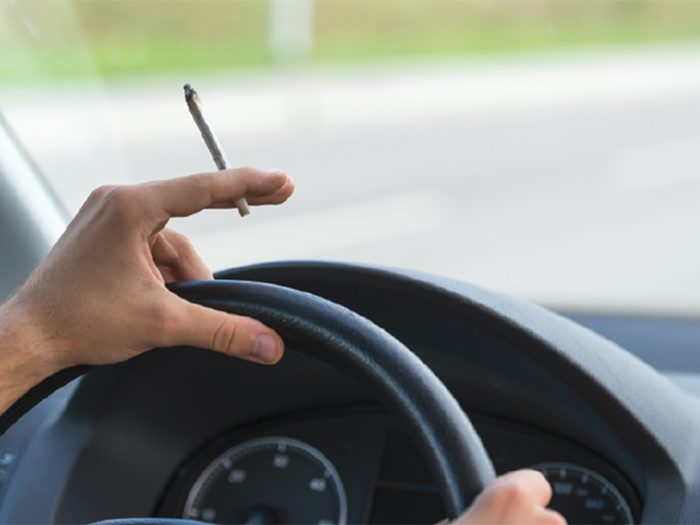Workplace Drug Use
Safety First

Transportation companies are taking a hard look at their zero tolerance policies now that 28 states have legalized the medical and/or recreational use of marijuana.
Knowing when to discipline an employee and when to stay one’s hand though, is going to be difficult. Traces of the nonactive ingredients of marijuana can remain in a person’s system for days, even months. It will be hard to determine whether an employee was getting high on the job or is simply testing positive after a long weekend.
One thing experts agree on is that the goal of any kind of test should be to determine whether a worker can do their job safely and effectively.
“No matter what type of drug, whether it’s legal or illegal, including prescribed medication, we need to understand how they can impact workers’ ability to perform job functions, especially when operating vehicles or machinery,” said Paul Baute, a vice president within Marsh Risk Consulting’s fleet safety practice in Indianapolis.
“We need to keep safety paramount.”
“The principal question they want to determine is whether the drugs can affect job performance, and particularly whether safety can be affected because an employee is working under the influence.” — Paul Baute, vice president, Marsh Risk Consulting
Commercial drivers are allowed a certain threshold of marijuana in their system by the U.S. Department of Transportation (DOT).
That threshold cannot exceed 50 nanograms of THC per milliliter of urine, Baute said.
Under DOT requirements, employers will also conduct confirmatory tests with a cutoff of 15 ng/ml. If a worker exceeds the initial cutoff, their case is referred to a substance abuse professional.
That consultant in turn works with the employee and their doctor to determine whether there is a prescribed or over-the-counter medication that could have been the reason for the positive result.
If the employee still tests below the 50 ng/ml cutoff no matter the drug, then that would mean for work purposes, the substance is not in their system — zero tolerance really means that an employee cannot have an amount above the cutoff, he said.
For workers testing positive, employers could have a zero tolerance policy or they could have a rehabilitation policy, which is allowed by the DOT.
Employers can have separate drug testing policies for non-CDL drivers and operators of machinery, and still another for all other types of employees, such as office workers, Baute said.
“The principal question they want to determine is whether the drugs can affect job performance, and particularly whether safety can be affected because an employee is working under the influence,” he said.
Hair sampling is relatively inexpensive and the results are quick, but it tests for the longest time frame that the drugs could be found in the body, Baute said.
Which Test is the Right One?
The DOT’s primary test is a urine test, but the agency will accept a blood sample if a worker is involved in a collision and is unable to provide a urine sample at the time of the accident.

David Mitchell, director of risk control and safety, Aon Risk Solutions
David Mitchell, director of risk control and safety for Aon Risk Solutions’ transportation and logistics practice in Little Rock, Ark., said the DOT determined that the urine tests would not change because of all of the new state laws legalizing marijuana.
Some fleets use hair testing in addition to urine testing, but the method is at a “tentative stage right now,” as the Motor Carrier Safety Administration has not approved hair testing.
“It’s a very sensitive safety risk management position at this time,” he said.
“Hair testing adds costs and that would be an additional fleet determination if they think it’s worth it for their own company culture.”
Regarding random testing, the federal agency last year reduced the percentage of drivers that are required to have such tests by 50 percent, because the previous years’ positive results “were so low there was no justification in the higher test rate,” Mitchell said.
“Drug use among truck drivers is not high, and drugs are not the cause of many crashes,” he said.
“To prevent serious crashes, fleets that reduce driver fatigue, alcohol use, inattention and tailgating are having great results.”
Barry Sample, senior director of science and technology at Quest Diagnostics Employer Solutions in Seneca, S.C., said that there really hasn’t been much, if any, change in drug test cutoffs from the firm’s employer clients operating in the states that now allow for medical and/or recreational use of marijuana.
For those states that have had these laws for a longer time — Colorado and Washington — Quest’s clients have inquired whether they can remove marijuana from the panel or change the cutoff, but to date haven’t changed their policies.
“These inquiries are more from employers that are having difficulty finding qualified employees and they are now making a risk determination,” Sample said.
“Right now, they are not willing to take the risk of changing their drug testing policies because they don’t know the impacts to productivity and safety.”
Still, Quest is continuing to monitor possible changes in ordering patterns by employers.
“I would advise employers to continue to look at their employee base and make risk-based decisions as to what drug testing is important to help ensure that they have a safe as well as a productive workforce,” Sample said.
Mark A.R. Kleiman, professor of public policy at New York University, said that some companies use drug testing to screen employees for other characteristics that might be correlated with drug use, such as whether the person “has a taste for breaking the law.” Some employers just believe that marijuana users “are not good people.”
“But then you have to ask whether it’s an employer’s rule to enforce the law, or moral views, with respect to employees’ private lives,” Kleiman said.
It’s Not Drug Testing; It’s Impairment Testing

Ellen Komp, deputy director, California NORML
Ellen Komp, deputy director of the cannabis advocacy group California NORML in San Francisco, said that urine testing has never been scientifically shown to be safe or effective at improving workplace safety or productivity.
Komp cited a 1985 consensus report of medical expert opinion in the “Journal of the American Medical Association,” concluding that drug tests are an inherently unreliable indicator of drug impairment.
“Workplace drug testing programs are essentially spying on workers outside of the workplace, because they do not necessarily show whether a person is actually impaired if they smoked marijuana days earlier and traces of the drug have remained in the system,” she said.
“Hair sampling in particular can pick up marijuana use months earlier. It’s not a good way to ensure safety in the workplace, but rather a way to discriminate against workers.”
The advocacy group does support impairment testing “as a better way to ensure safety without discriminating against workers,” Komp said.
Bowles-Langley Technology Inc. developed an impairment testing application, and a 2009 study of the application under a grant by the National Institute for Occupational Safety and Health showed that such testing for fatigue and impairment in the workplace is both feasible and practical, said Henry M. Bowles, CEO of the Alameda, Calif. firm.
He also is a board member of Predictive Safety in Centennial, Col., which merged with Bowles-Langley last year and is now “leading the charge” for commercialization, conducting pilot studies with several companies including mining companies in South Africa.
It launched a mobile app, AlertMeter, which measures reaction time, decision-making and pattern recognition. The quick minute-plus test can be taken before or just as a person gets to work, and the results are transmitted to a common database that can be monitored by a safety manager.
Individuals take the test 10 times to establish personal baselines and then are tested against their own baseline. The software adjusts the baseline as people get better and better at taking the tests, but if people score significantly below their baseline both on an initial test and a retest, then their supervisor is alerted.
“Company policy should be in place to help a manager make a decision about what should happen,” Bowles said. “It could be that the individual stayed up with a sick child and maybe just needs to work on a computer instead of a forklift for the day.”
Bowles stressed that the firm is not trying to “overthrow the chemical drug testing regime” because it is pretty well-embedded in law, particularly for DOT-regulated companies. However, fatigue is not detected “or considered important” in the current system of drug testing.
“We’re seeing that a lot of impairment occurs because of fatigue as well as from the use of drugs, both legal and illegal,” he said.
“More and more companies are telling us, especially with the legalization of marijuana, that impairment testing makes the most sense.” &










